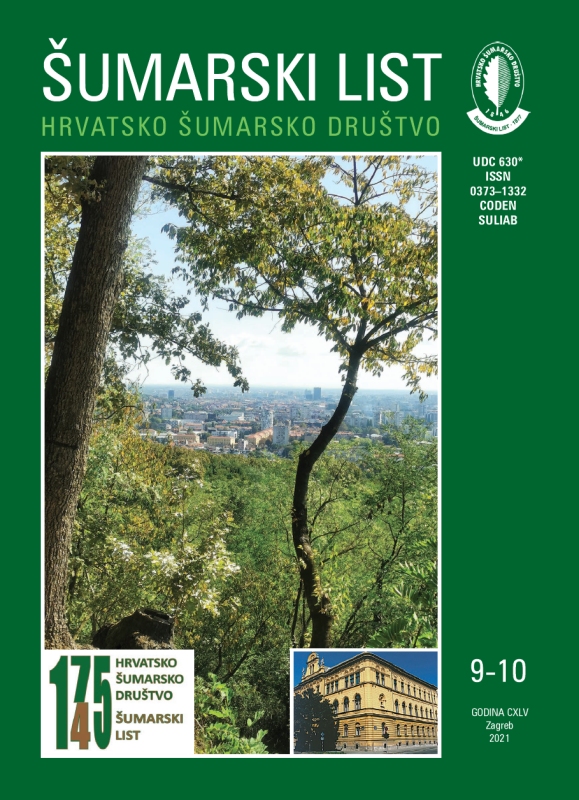
broj: 9-10/2021
pdf (9,32 MB) |
|
||||||||||||||
| RIJEČ UREDNIŠTVA | ||
| Uredništvo | ||
| What does the new EU forest strategy for 2030 bring? pdf HR EN | 413 | |
| IZVORNI ZNANSTVENI ČLANCI | ||
| Željko Škvorc, Lucija Lisica, Vanja Zorić, Marko Bačurin, Krunoslav Sever | UDK 630* 164 +111.8 (001) https://doi.org/10.31298/sl.145.9-10.1 | |
| Functional differentiation of holm oak provenances in the east Adriatic coast pdf HR EN | 415 | |
| Vlado Jumić, Tihomir Florijančić, Tomica Marić, Siniša Ozimec, Krešimir Krapinec | UDK 630* 156 (001) https://doi.org)10.31298/sl.145.9-10.2 | |
| May the trophy evaluation variables be utilized as population indices in cervids:Example of the red deer from the hilly part of the Pannonian plain? pdf HR EN | 423 | |
| Zoran Galić, Alen Kiš, Radenko Ponjarac, Miljan Samardžić, Anđelina Gavranović, Zoran Novčić, Irina V. Andreeva | UDK 630* 114 (001) https://doi.org)10.31298/sl.145.9-10.3 | |
| Analysis of soils spatial differentiation and productivity in forest management unit Muzljanski rit pdf HR EN | 445 | |
| Milica Caković, Aleksandar Baumgertel, Sara Lukić, Nada Dragović, Miodrag Zlatić | UDK 630* 164 (001) https://doi.org/10.31298/sl.145.9-10.4 | |
| Effects of biological works within the integrated watershed management of torrent catchments in the area of Grdelica Gorge and Vranjska Valley (Serbia) pdf HR EN | 459 | |
| Deniz Güney, Ali Bayraktar, Fahrettin Atar, Ibrahim Turna | UDK 630* 232 (001) https://doi-org/10.31298/sl.145.9-10.5 | |
| The effects of different factors on propagation by hardwood cuttings of some coniferous ornamental plants pdf HR EN | 467 | |
| STRUČNI ČLANCI | ||
| Damir Ugarković, Matko Matijević, Ivica Tikvić, Krešimir Popić | UDK 630* 111.8 https://doi.org/10.31298/sl.145.9-10.6 | |
| Some features of climate and climatic elements in the area of the city of Zagreb pdf HR EN | 479 | |
| Katarina Tumpa, Marilena Idžojtić, Mirna Ćurković-Perica, Marin Ježić, Davor Juretić, Damir Drvodelić, Mario Šango, Milovan Žigante, Igor Poljak | UDK 630* 181.5 https://doi.org/10.31298/sl.145.9-10.7 | |
| Vegetative propagation of sweet chestnut and marrons pdf HR EN | 489 | |
| Summary Selected varieties of sweet chestnut called marrons are cultivated for their large and exquisite fruits. Most of the countries with native sweet chestnut populations have their autochthonous varieties that were arduously created through selective breeding over many centuries. Marron cultivation has a long history in Croatia, mostly in the Lovran area and its surroundings. Although threatened by pests and diseases, as well as land abandonment, some growers still practice the traditional cultivation methods. This paper provides an overview of the most common vegetative propagation methods utilized for the sweet chestnut and marrons sapling production, as well as a shorter overview of cultivation methods, breeding, and the importance of marron plantations in Croatia. Identical fruit characteristics can be inherited by progenies only through faithful passing on of the parent’s genotype, thus marrons are propagated vegetatively. Grafting is the most common method of vegetative propagation of marrons in tree nurseries. Other vegetative methods discussed are propagation by layering, cuttings and tissue culture, occasionally used in the reproduction of sweet chestnut. Key words: vegetative propagation; grafting; marrons; sweet chestnut; varieties | ||


